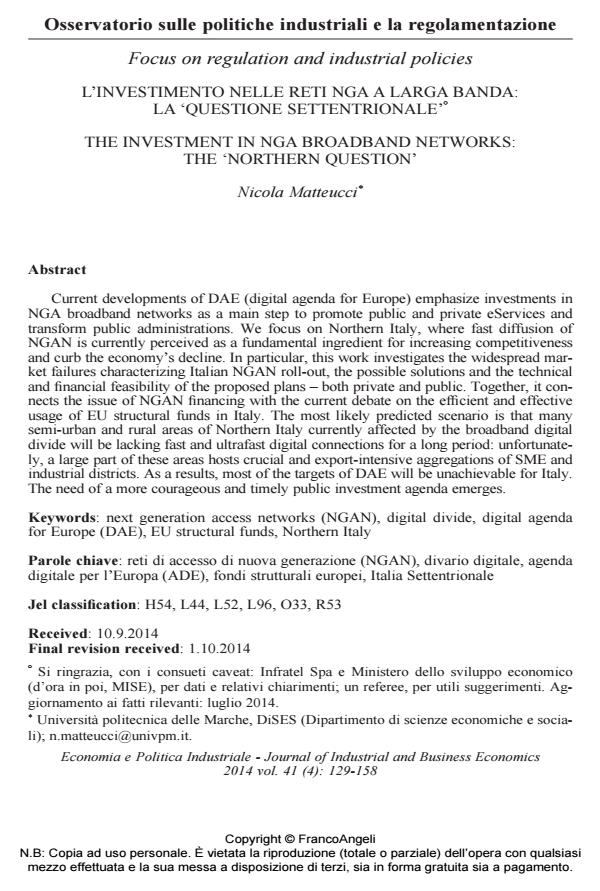L’investimento nelle reti NGA a larga banda: la "questione settentrionale"
Titolo Rivista ECONOMIA E POLITICA INDUSTRIALE
Autori/Curatori Nicola Matteucci
Anno di pubblicazione 2014 Fascicolo 2014/4
Lingua Inglese Numero pagine 30 P. 129-158 Dimensione file 116 KB
DOI 10.3280/POLI2014-004007
Il DOI è il codice a barre della proprietà intellettuale: per saperne di più
clicca qui
Qui sotto puoi vedere in anteprima la prima pagina di questo articolo.
Se questo articolo ti interessa, lo puoi acquistare (e scaricare in formato pdf) seguendo le facili indicazioni per acquistare il download credit. Acquista Download Credits per scaricare questo Articolo in formato PDF

FrancoAngeli è membro della Publishers International Linking Association, Inc (PILA)associazione indipendente e non profit per facilitare (attraverso i servizi tecnologici implementati da CrossRef.org) l’accesso degli studiosi ai contenuti digitali nelle pubblicazioni professionali e scientifiche
Current developments of DAE (digital agenda for Europe) emphasize investments in NGA broadband networks as a main step to promote public and private eServices and transform public administrations. We focus on Northern Italy, where fast diffusion of NGAN is currently perceived as a fundamental ingredient for increasing competitiveness and curb the economy’s decline. In particular, this work investigates the widespread market failures characterizing Italian NGAN roll-out, the possible solutions and the technical and financial feasibility of the proposed plans - both private and public. Together, it connects the issue of NGAN financing with the current debate on the efficient and effective usage of EU structural funds in Italy. The most likely predicted scenario is that many semi-urban and rural areas of Northern Italy currently affected by the broadband digital divide will be lacking fast and ultrafast digital connections for a long period: unfortunately, a large part of these areas hosts crucial and export-intensive aggregations of SME and industrial districts. As a results, most of the targets of DAE will be unachievable for Italy. The need of a more courageous and timely public investment agenda emerges.
Parole chiave:Reti di accesso di nuova generazione (NGAN), divario digitale, agenda digitale per l’Europa (ADE), fondi strutturali europei, Italia Settentrionale
Jel codes:H54, L44, L52, L96, O33, R53
- Innovations in Digital Economy Kirill Sarachuk, Magdalena Missler-Behr, Adrian Hellebrand, pp.40 (ISBN:978-3-030-84844-6)
- La copertura digitale del territorio rurale: un'analisi sui comuni marchigiani Marco Lorenzetti, Nicola Matteucci, in ECONOMIA E SOCIETÀ REGIONALE 2/2016 pp.92
DOI: 10.3280/ES2016-002007 - Sviluppo socio-economico e dotazione di banda larga nei comuni marchigiani Marco Lorenzetti, Nicola Matteucci, in PRISMA Economia - Società - Lavoro 3/2018 pp.199
DOI: 10.3280/PRI2016-003014 - E-government e capitale umano nella Pubblica Amministrazione italiana. Una prospettiva di medio periodo Nicola Matteucci, in PRISMA Economia - Società - Lavoro 2/2020 pp.31
DOI: 10.3280/PRI2019-002003 - Diffusione tecnologica e ICT: modelli ed applicazioni Silvio Di Fabio, in PRISMA Economia - Società - Lavoro 3/2018 pp.92
DOI: 10.3280/PRI2017-003009
Nicola Matteucci, L’investimento nelle reti NGA a larga banda: la "questione settentrionale" in "ECONOMIA E POLITICA INDUSTRIALE " 4/2014, pp 129-158, DOI: 10.3280/POLI2014-004007